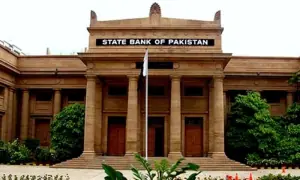Pakistan’s outlook remains challenging, says IMF report
The International Monetary Fund has acknowledged Pakistan’s economic improvement, however, warned that the outlook remains challenging, with downside risks remaining exceptionally high.
“The signs of economic stabilization are strengthening, with gradual disinflation underway and external pressures easing further since the first review on the back of improved fiscal balances,” the board said in its summary of the country report on Friday.
Pakistan last month completed a short-term $3 billion programme, which helped stave off sovereign default, but the government of Prime Minister Shehbaz Sharif has stressed the need for a fresh, longer-term programme.
The report was released on the day when an IMF mission arrived in Pakistan to discuss a new loan programme.
Pakistan’s financial year runs from July to June and its budget for fiscal year 2025, the first by Sharif’s new government, has to be presented before June 30.
According to the report, inflation developments have generally been close to the first review’s expectations, but food inflation has slowed somewhat more gradually than anticipated. As a result, year-end inflation in FY24 and FY25 has been revised up modestly.
For FY24, the lender has projected the current account deficit (CAD) at $3 billion (0.8 per cent of GDP), somewhat lower than projected at the first review.
“A more muted import rebound is now expected, reflecting favorable commodity price changes and a larger than anticipated drop in food and cotton imports given the domestic agricultural recovery, while exports are slightly higher,” it said and added that the staff expected the CAD to remain around 1½ per cent of GDP over the medium term, reflective of a flexible exchange rate consistent with efforts to rebuild reserves.
Moreover, the end-FY24 debt-to-GDP ratio was projected to decrease markedly, driven by fiscal consolidation and ex-post negative real interest rates.
“That said, risks to debt sustainability remain acute given very large gross financing needs and the persistent challenges in obtaining external financing, and that real interest rates are projected to become an adverse driver of debt dynamics in the coming years. Provided that program policies are sustained over the medium term and assuming adequate multilateral and bilateral financial support, public debt would remain sustainable and on a downward path.”
While the new government has indicated its intention to continue the SBA’s policies, the lender said that the political uncertainty “remains significant”.
A resurgence in social tensions (reflecting the complex political scene and high cost of living) could weigh on policy and reform implementation, it added.
“Policy slippages, together with lower external financing, could undermine the narrow path to debt sustainability and place pressure on the exchange rate. Delays in post-program external financing disbursements would also place further pressure on banks to finance the government [further exacerbating crowding out of the private sector],” it said and added that geopolitically driven higher commodity prices and disruptions to shipping, or tighter global financial conditions, would also adversely affect external stability.
The 65-page report also mentioned that the authorities were moving forward with plans to privatise Pakistan International Airlines (PIA) and other assets and have advanced their broader privatisation agenda.
“The authorities aim to complete, by June 2024, the bidding for PIA’s core business, of which the government would likely seek to sell a (controlling) 51 percent stake,” it said.
To limit state balance sheet implications, the use of divestment proceeds would prioritise the settling of governmentguaranteed debt—to be transferred from PIA’s balance sheet to a holding company—held by commercial banks (PRs 242 billion, of a total of PRs 629 billion in liabilities to be transferred). Several smaller SOEs are also currently on an active privatisation list.
“Debt sustainability remains a large risk,” the report said. The IMF has stressed that continued revenue-driven fiscal consolidation was critical.
Also, read this
In meeting with IMF MD, PM Shehbaz vows to put economy back on track
The board has warned that the central bank must remain vigilant as the inflation remains high despite the disinflation trajectory.
“Likewise, a flexible exchange rate is key to moderating balance of payments pressures and rebuilding international reserves,” it said, “significant progress was made over a short period on the structural reform agenda [though the creation of the SWF and SIFC in August 2023 pose risks to the SOE reform and business environment agendas].”
For the latest news, follow us on Twitter @Aaj_Urdu. We are also on Facebook, Instagram and YouTube.





















Comments are closed on this story.